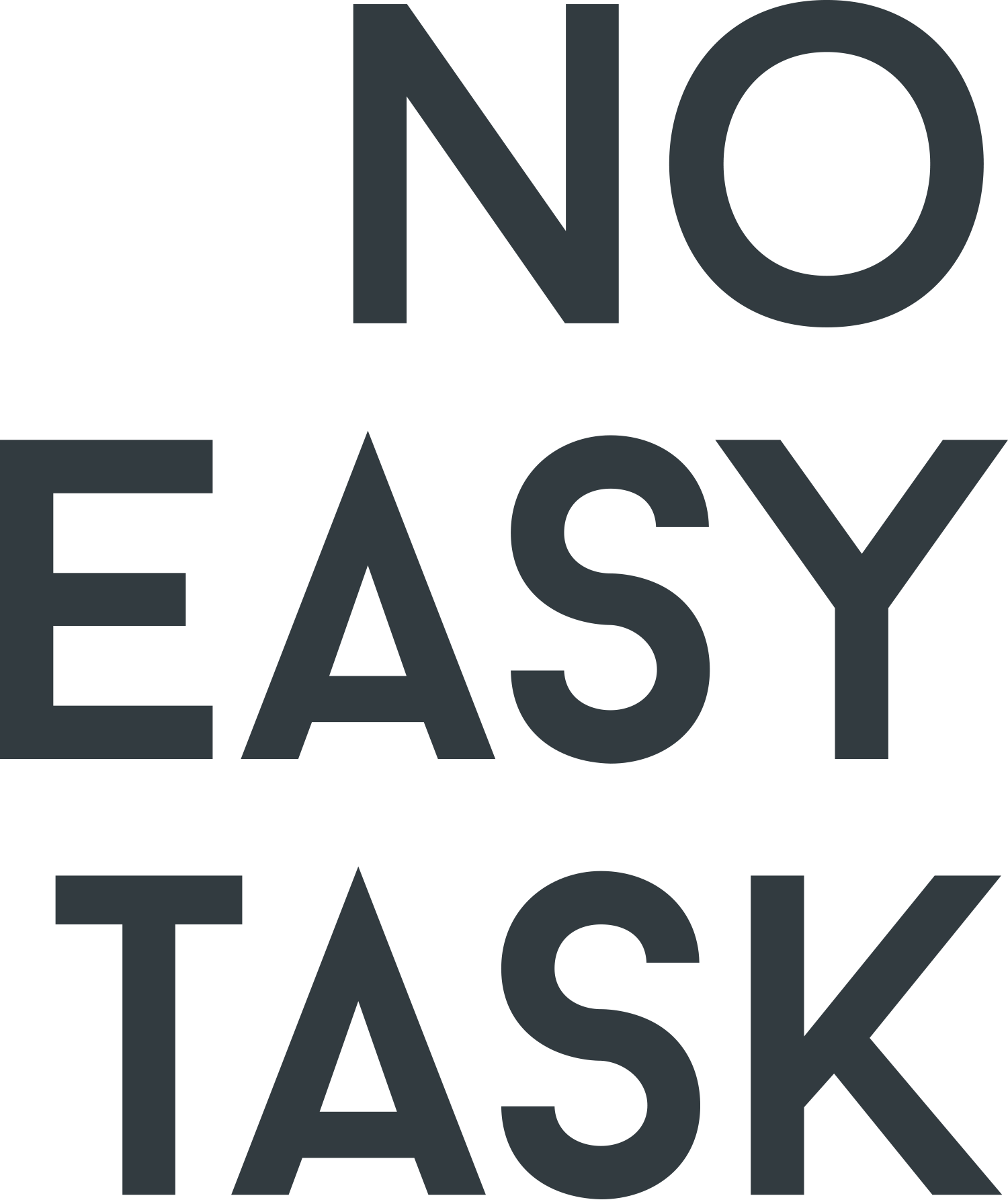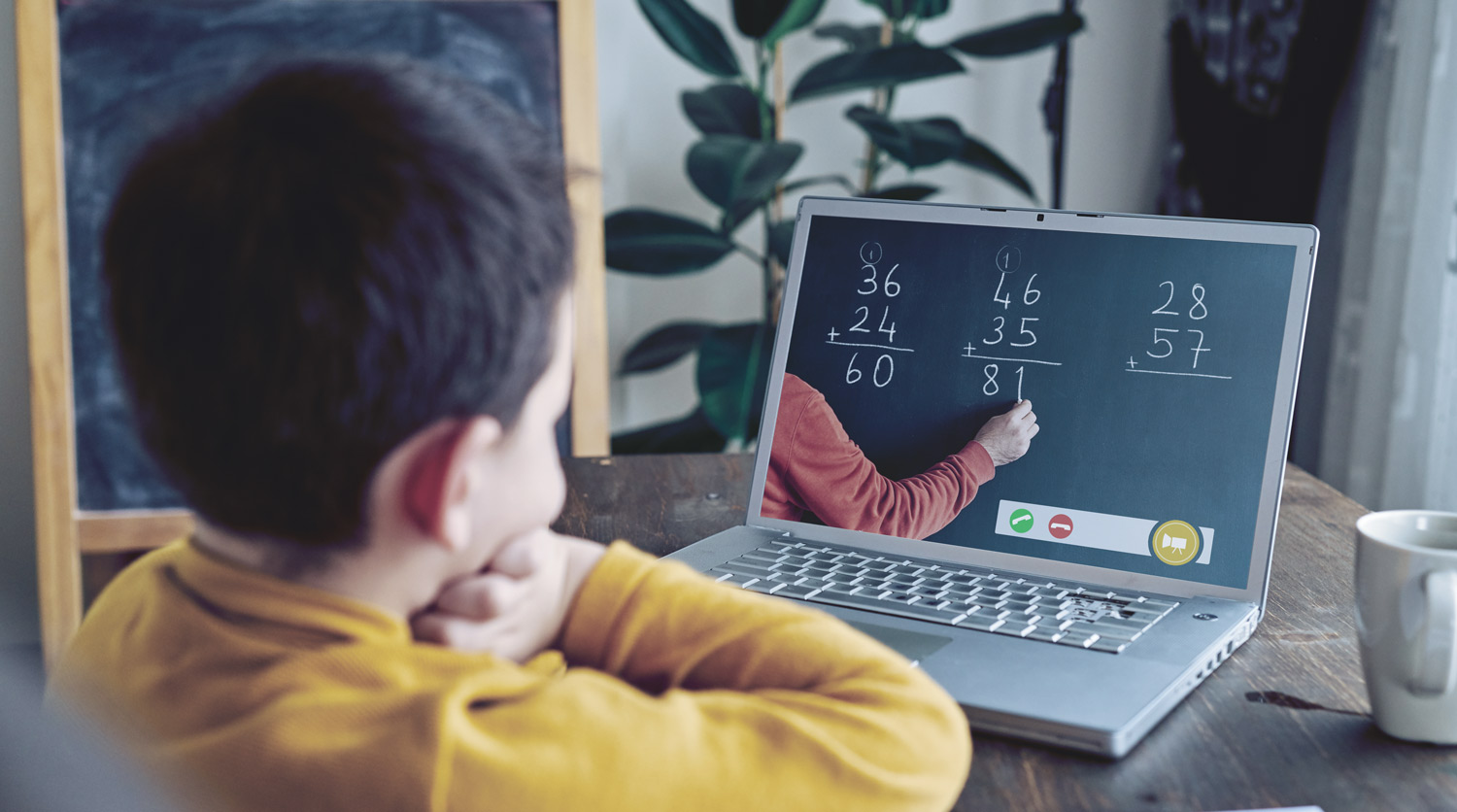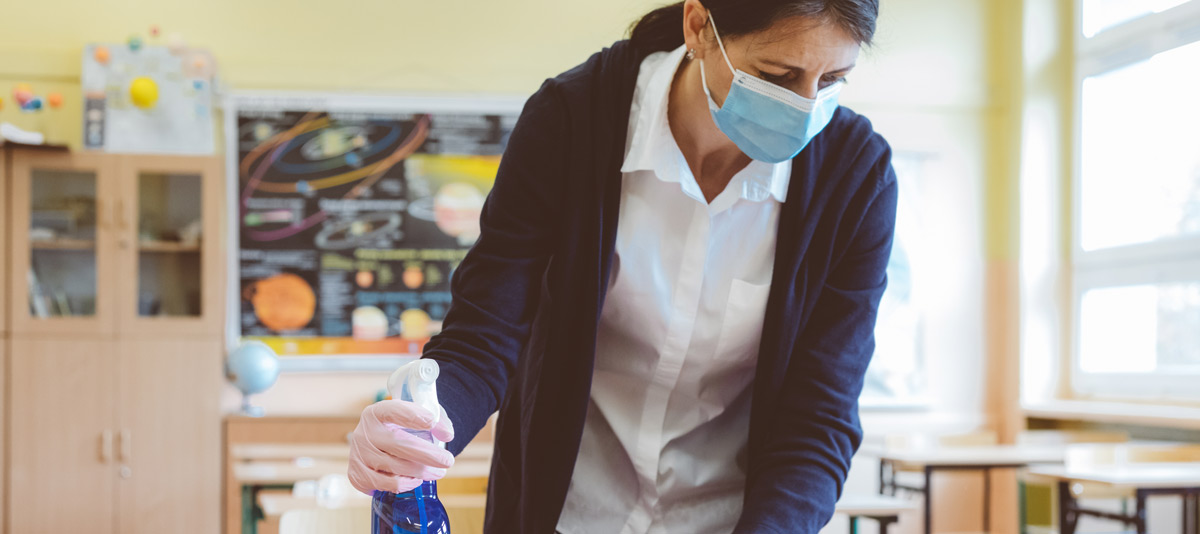


Understandably, like millions across California, they want to know what the 2020–21 school year will look like. Will students be in the classroom five days a week? If so, when will the day start and how will they get to school? Will they need to wear face coverings at all times? Will they be able to play sports or participate in activities such as band or orchestra?
For roughly 90 percent of the state’s schoolchildren and their families, answers for the immediate future would arrive on July 17, when Gov. Gavin Newsom mandated that all schools in counties on the state’s COVID-19 monitoring list begin the school year solely with distance learning and must meet strict criteria in order to open campuses. The shift away from local control came days after a flurry of urban and suburban districts throughout the state, citing rampant community spread of the disease, followed Los Angeles Unified School District and San Diego USD in announcing they would only offer remote learning to begin the academic year.




Understandably, like millions across California, they want to know what the 2020–21 school year will look like. Will students be in the classroom five days a week? If so, when will the day start and how will they get to school? Will they need to wear face coverings at all times? Will they be able to play sports or participate in activities such as band or orchestra?
For roughly 90 percent of the state’s schoolchildren and their families, answers for the immediate future would arrive on July 17, when Gov. Gavin Newsom mandated that all schools in counties on the state’s COVID-19 monitoring list begin the school year solely with distance learning and must meet strict criteria in order to open campuses. The shift away from local control came days after a flurry of urban and suburban districts throughout the state, citing rampant community spread of the disease, followed Los Angeles Unified School District and San Diego USD in announcing they would only offer remote learning to begin the academic year.
 or all involved in K–12 education, the planning for this year is nothing like in years past and takes on added urgency for counties not on the monitoring list, such as Northern California’s Plumas. Plumas USD and County Board of Education trustee Dwight Pierson knows that well into July and possibly into early August, the governing board and administrators will still be weighing options and may have more questions than answers; as of this writing, the district plans to open the school year on Aug. 24 by providing three options to families: a part-time in-person model, a 100-percent online option and an independent study program.
or all involved in K–12 education, the planning for this year is nothing like in years past and takes on added urgency for counties not on the monitoring list, such as Northern California’s Plumas. Plumas USD and County Board of Education trustee Dwight Pierson knows that well into July and possibly into early August, the governing board and administrators will still be weighing options and may have more questions than answers; as of this writing, the district plans to open the school year on Aug. 24 by providing three options to families: a part-time in-person model, a 100-percent online option and an independent study program.
Even in a rural area less impacted by COVID-19, decisions may not hold true for the entire academic year — concerns of a second wave of cases this fall cast a giant shadow even as the state struggles mightily to contain a summer surge — and will not satisfy what all stakeholders want to see.
The pressure and scrutiny on decision-makers is immense as public education has been thrust into the spotlight as a fulcrum in determining the shape and pace of the state’s recovery from a crippling disease. The high-pressure environment impacts leaders not only of schools that will open the year with some form of in-person instruction, but for officials who will have to determine how and when campuses should reopen once their counties exit the watch list.
“At our Zoom meeting one night, we had 157 participants listening. Well, we never had anybody come to board meetings, but we had 157 people on Zoom as guests,” said Pierson, who served as a longtime superintendent in Iowa before moving to rural Northern California. “It’s almost overwhelming because everybody has an opinion on COVID and what we should do.”
The ever-shifting situation is compounded by an environment in which school leaders say they lack the funding, resources and clear direction to effectively implement health and safety recommendations from federal, state and local public agencies. “They’re just kind of saying, ‘Do it. Go ahead, go ahead and do it, and then we’ll figure out if you did it right later,’” Pierson said of the overall vagueness from state and federal officials. “What we’re trying to do is to come up with the best program that will serve the kids the best we can with our existing resources.”

After a dramatically uneven spring of emergency-mode distance learning across the state, the following are required in the 2020–21 school year under Senate Bill 98, the education trailer bill:
- Daily live interaction with certificated employees and peers as part of regular instruction when feasible
- Daily tracking and weekly monitoring to verify participation and progress
- Access to connectivity and devices
- Content at a level substantially equivalent to in-person instruction
- Academic and other supports to students not performing at grade level
The challenges of safely reopening schools run the gamut from providing personal protective equipment to finalizing instructional and operational services such as lesson delivery models, transportation and meals, to considerations for how to accommodate learning loss and the growing mental health needs of students and staff. And in the now-widespread distance learning realm, districts continue to grapple with the fact that one million students don’t have the technology and/or high-speed internet access necessary to participate in distance learning, according to the California Department of Education.
As leaders work through these decisions for the 2020–21 school year and beyond, the expectations of state officials, legislators and the general public often don’t align with the stark reality at hand. “As one school board member said to me, ‘It’s like they want us to start at the finish line,’” said Sonoma County Board of Education trustee Gina Cuclis, who also serves as CSBA Region 3 County Delegate.
And while none of the choices are easy for board members, administrators and educators after already triaging their way through the remainder of a difficult 2019–20 school year, what is clear is that leaders up and down the state are leaving no stone unturned to find what they think is going to deliver the best outcome for students. The difficult circumstances have also borne out newfound ingenuity and collaboration, as well as shone a bright light on areas that have long lingered in the shadows.
“We’re elected to solve problems. I think that’s where I’m at,” Cuclis said. “I think, when I talk to other trustees and our districts, that’s where we’re all at. You just have to do what you have to do, and it’s not perfect.
“It’s kind of a cliché now to say, ‘This is unprecedented,’” Cuclis added. “It is unprecedented, and I’m tired of the cliché, because we all know that, so we’re just doing the best we can with the information we get and understanding what our students’ needs are.”
CSBA CEO & Executive Director Vernon M. Billy acknowledged the monumental task facing school leaders in his letter introducing CSBA’s reopening guidance report, The Uncertain Road Ahead: Reopening schools in the time of COVID-19.
“The typically demanding process of preparing for the start of school carries even greater urgency this summer,” Billy wrote. “As board members, you face the challenge of making decisions while battling several invisible adversaries: a virus we don’t fully understand, guidance that is typically insufficient and occasionally nonexistent, and funding that is inadequate to cope with the added expense and logistical challenges of responding to COVID-19.”
Based on budgets and resources, available classroom and other campus space, labor agreements and local health guidance, some districts planned to start the year fully with distance learning while others that are eligible to do so will bring students back to class full-time with myriad safety measures in place. Before the new state guidance prevented them from doing so, a majority leaned toward a hybrid plan landing somewhere in the middle, often comprising cohorts of students alternating days in which they come to campus.
Beyond the more broadly offered instructional models, local educational agencies are also working to best accommodate students and staff who cannot return to the classroom due to health concerns, as well as families uncomfortable with in-person instruction until the availability of a vaccine or herd immunity, for example. Many districts have turned to online surveys to gauge interests and needs.
Cathy Nichols Washer, superintendent of Lodi USD, told the district’s board at a June meeting that the results of a survey showed that 27 percent of district parents preferred an all-distance learning model for the fall, as did 28 percent of teachers. Similarly, Sonoma County Superintendent Steve Herrington said between 15 and 22 percent of parents said they would keep their children home should schools allow students to come back for in-person instruction. While both San Joaquin and Sonoma counties are on the monitoring list and won’t be able to open their doors to start the year, leaders said the feedback would help guide planning for an eventual return to campuses.
Deep into the summer, many families and community members were still holding out hope for a return to the way things used to be — both in education and in society at large. “The community wants to go back to normal. There is no normal anymore,” Conejo Valley USD board president Cindy Goldberg said in late June.
Prior to Gov. Newsom’s announcement on continued closures, the Ventura County district planned to offer three flexible learning models from which families can choose: in-person, hybrid and distance. “There will be some fluidity at semester marks and things like that for people that want to weave back and forth, but we’re trying to craft a plan that will work no matter what happens,” Goldberg said in the interview prior to the new state guidance. “If the numbers keep going up, maybe we won’t be allowed to be in person at all, but who knows? So we want to be as flexible and nimble as possible and still try to do something that keeps the social-emotional health of our students at the forefront and with their health and safety, both physically and mentally, in mind.”
In Plumas County, CSBA Region 2 Delegate Pierson said joint county and district officials have shown a great interest in offering a hybrid approach, but the digital divide is a roadblock due to the size and rural nature of the area.

On top of the untold issues facing local educational agency leaders in planning for the 2020–21 school year was a waiting game as the state finalized its budget. After a week of negotiations, the Legislature and Gov. Gavin Newsom compromised on a spending plan that leans heavily on one-time federal money and apportionment deferrals in lieu of cuts to K–12 education funding.
While presenting challenges for LEAs such as the prohibition of layoffs for certificated and specified classified employees (nutrition, transportation or custodial services) in 2020–21, the budget importantly rejects the devasting 10 percent cut to the Local Control Funding Formula that was proposed in the Governor’s May Revision. CSBA and its members advocated arduously with the administration and lawmakers to adopt a 2020–21 budget that provides sufficient funding to safely reopen schools this fall.
“I think school board members meeting with their legislators and hearing from us has made a difference,” said Sonoma County Board of Education trustee Gina Cuclis. “They really heard us. ‘No, we can’t allow this 10 percent cut. We can’t do this.’ I really think our advocacy on that made a difference.”
Further stimulus aid could eventually arrive from Congress and rescind $5 billion of the $11 billion in apportionment deferrals from the state, but the consensus remains that the new school year will provide steep challenges. An analysis by the School Superintendents Association and the Association of School Business Officials, for example, found that the average U.S. school district may need to spend an additional $1.8 million to reopen school buildings, given new expenses for health monitoring and cleaning, additional staffing, protective equipment and transportation.
“I think the fact of the matter is whether or not we have more money or less money, school districts are going to have to do more,” Assembly Education Committee Chair Patrick O’Donnell (D-Long Beach) said at a June 16 hearing on reopening schools.
“As I get calls from parents, I’ve got some who have just been phenomenal working with their children, and most of them are working at home and were able to monitor their kids on their distance learning, and some have excelled in distance learning,” Pierson said. “I have other families that have both parents working. They have no child care options. Their children have been home often alone and with little or no connectivity.”
“They want their kids in school, but they really truly want it because they know that’s the safest place,” he added. “They know that they’re taken care of. They’re nurtured. They’re loved, hopefully, they’re learning. They’re safe.”
A return to full-time in-person classroom instruction, however, presents major obstacles, beginning with transporting students to and from school. “Do we run three times as many bus routes as we do now?” Pierson asked, also pondering options such as limiting the busing service area or contracting with parents to transport their children, a tactic he used in Iowa during budget crunches.
The vast diversity of California’s more than 1,000 school districts means that what works in one may not work in another, further muddling a process with no precedent to draw upon. Well-intentioned guidance and recommendations cannot simply be applied with broad strokes, Cuclis said. “Our smallest school district only has about a dozen students, and it’s in a very rural school district, on an Indian reservation. And the largest is Santa Rosa City Schools (roughly 16,000 students). So, their needs are all different.”
While the oversight of county-run alternative schools, their affiliated programs and 40 school districts is challenging, Cuclis said that she empathizes greatly with district trustees facing a seemingly insurmountable number of issues at every turn. “My heart has gone out to them, because they’re dealing more with the nitty-gritty uncertainty of parents and teachers wanting more certainty.”
Further complicating preparations for the 2020–21 school year is that students will return to coursework — a vast majority of them continuing with distance learning and the challenges inherent to a digital learning environment — after an interrupted year and with little to no chance for summer learning, enrichment programs and social interaction. Researchers and school officials alike have major concerns about the impact of learning loss and the social-emotional health of many students, particularly those who traditionally struggle.
“That’s the front-burner issue when school starts — learning loss. Because you have to work that in for the whole school year,” Cuclis said. “Some children, some students, are going to suffer much greater and be farther behind than others. That’s going to be the front burner. And then student well-being and mental health, for us, I know that that’s another priority, and also a long-range view priority.”
Pierson shares the same concerns. “Kids lost three months of school [last] school year,” he said. “They normally regress during the summer, especially challenged children. We may have students that maybe lost a year in learning, and so now what do we do?”
The education nonprofit NWEA estimates that, with distance learning, the average growth trajectory in reading for students in grades 3-8 would be about 70 percent of what would be expected in a typical school year. More dramatically, in math, students’ estimated average learning gains would drop to about 50 percent of what one would expect under normal conditions for grades 3-8.
Challenges with distance learning and learning loss can be approached in a number of different ways. In the Bay Area’s Marin County, inequitable access to virtual lessons was cited as the main reason the county office of education initially recommended in-person instruction as the preferred method for a return to instruction this fall; the county office later advised a broad adoption of distance learning and the offering of in-person services to a limited number of students. “We also know that the social-emotional needs of our children are best met through the special relationships that are developed with their peers, their teachers and school staff. The best place for students is in their schools,” county Superintendent Mary Jane Burke said in June a statement.

Burke’s comments on distance learning echo the sentiments of State Superintendent of Public Instruction Tony Thurmond, who has repeatedly said that, even with the best efforts of schools in transitioning to distance learning, far too many students and teachers were left behind in the spring. “This pandemic uncovered an embarrassing reality that we’ve had a digital divide in California for decades,” Thurmond said during a Digital Divide Task Force meeting.
CSBA has earned praise from Thurmond and other state officials for the association’s help in identifying LEAs with students struggling with device and connectivity issues. CSBA also continues to work with the state and private-sector partners to complement collaborations that will provide devices and hot spots to students across the state.
In her community, Conejo Valley USD’s Goldberg said despite some of the early struggles witnessed with distance learning, a focus on providing internet access and devices provided valuable insights and lessons that can be drawn upon in the new school year.
One of the guiding lights for Goldberg during this roller-coaster ride of governance is to look at the bright side of things, or, rather, the opportunity to re-envision public education and to home in on persistent achievement gaps by engaging more meaningfully with underserved populations in a district with only a 27 percent unduplicated pupil rate. “They are often invisible, which is a problem,” she said. “This whole emergency crisis learning has showed those holes and given us opportunities to shore up those holes, which has been great. And we don’t want to lose that momentum moving forward.
“It’s time to push the reset button,” Goldberg concluded about the new school year’s opportunities. “And sometimes it takes a little while to boot up, but I think that it gives you an opportunity to do it better.”
And for Pierson, an anecdote he shared at a board meeting represents his viewpoint headed into a school year of great uncertainty. “The best hitters in baseball only hit .300. I said, ‘If we could hit .700, I’d be pleased. If seven out of 10 of our decisions were good, that would be a great start. Then we can work on the ones that are not such great decisions to make them better as the year goes on.’ That’s kind of the philosophy we’re approaching.”
Andrew Cummins is a writer for California Schools.